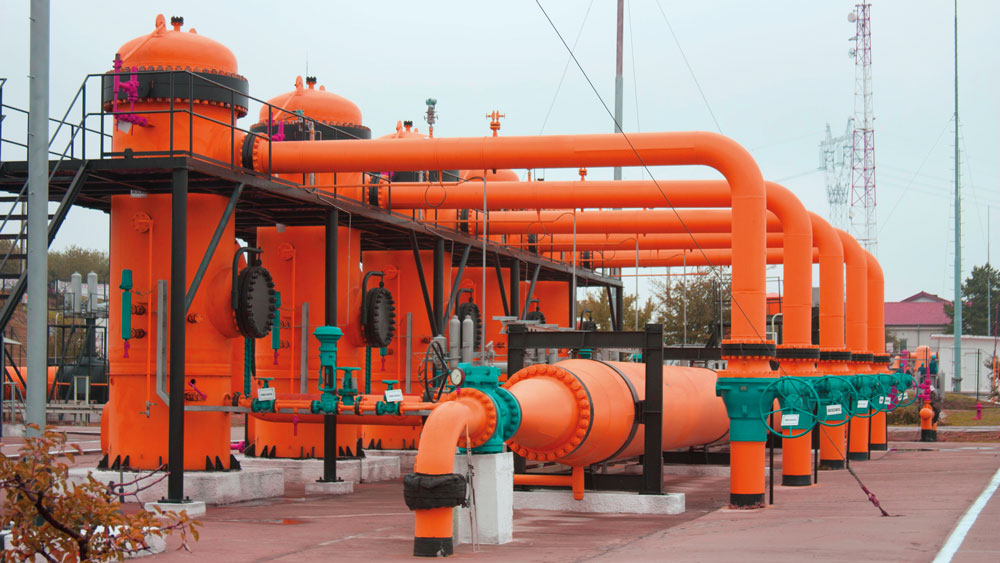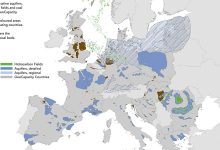Transgaz invests in eastern corridor development
Chisinau relies on the Black Sea to break the monopoly of giant Gazprom
The operator of the national gas transmission system, Transgaz, plans to develop the eastern corridor, through which gas to be extracted from the Black Sea, probably as of next year, will also reach the Republic of Moldova. Romania is currently connected to the Republic of Moldova through Iasi – Ungheni gas pipeline, inaugurated on 27 August 2014, precisely one year from the beginning of construction. In the first phase the gas pipeline would carry an estimated 500mln cubic meters of gas; in the next phase a compressor station will be constructed. The gas pipeline will be able to transport at a final capacity of 1.5bcm of gas, more than the 1.3bcm of gas representing the consumption demand of the Republic of Moldova.
To be able to ensure the parameters mentioned in the technical data sheet of the project for the interconnection of the national gas transmission system with the similar system in the Republic of Moldova, it’s necessary to achieve additional developments, both in the Romanian and in the Moldovan gas transmission systems. The technical solution agreed by the two states to increase the transmission capacity of the interconnection (1.5bcm per year or 171,000 cubic meters per hour at a pressure of 38 bars at the border), it’s estimated a value of EUR 110mln, according to the annual report of Transgaz, recently published. The development of the eastern corridor aims to ensure bidirectional interconnection with the Republic of Moldova, in Ungheni, and this requires the rehabilitation of some of the existing pipelines of this corridor, as well as the construction of new pipelines and the construction of compressor stations or the amplification of some of the existing ones (Onesti and Gheraesti).
Limited transmission capacities
In conditions in which gas exports through Iasi – Ungheni interconnector are still low, a new transmission infrastructure will be built on the territory of Romania for Romanian gas to reach Moldova. The project is considered ‘of national importance’ by the authorities in Bucharest and, once realized, it would allow the Moldovans to consume gas to be extracted from the Black Sea. In this regard, the Government of Romania last year adopted a decision on the ‘Development of capacity of the National Transmission System to ensure gas flow on Romania-Republic of Moldova direction.’
“Given the configuration of the two national transmission systems and their technical characteristics, possibility to transport gas in bidirectional flow between Romania and the Republic of Moldova are limited, because: 1) The gas transmission system of the Republic of Moldova is based on pipelines with relatively small diameters (DN 100 – DN 250), operated at high pressure, 35 – 55 bars and 2) The gas transmission system in Romania is largely made of pipelines between DN 250 – DN 800, operated at pressure of 10 – 35 bars, with the exception of pipelines making gas transit from the Russian Federation to the countries on the Balkan corridor,” the substantiation note of the decision adopted last year shows.
Investments to be made
The development of this gas transmission corridor considers ensuring operation at the designed technical parameters of physical reverse flow interconnection with the Republic of Moldova, and for this end it is necessary to rehabilitate some of the existing pipelines of this corridor, as well as to build new pipelines and build two new compressor stations, Transgaz’s strategy shows. In total, Transgaz’s project has a cost of EUR 131.7mln and involves the construction of two new gas pipelines, in the north-east of the country, and two compressor stations, according to the investment program of Transgaz. Investments will aim at:
- Construction of a new DN 700, Pn 55 bar 104 km gas transmission pipeline in the Onesti – Gheraesti direction. The route of this pipeline will be mostly parallel with the existing DN 500 Onesti – Gheraesti pipeline;
- Construction of a new DN 700, Pn 55 bar 61 km gas transmission pipeline in the Gheraesti – Letcani direction, this pipeline will replace the existing DN 400 Gheraesti – Iasi pipeline on the Gheraesti – Letcani pipeline section;
- Construction of a new gas compressor station at Onesti, having an installed power of 9.14 MW, 2 compressors of 4.57 MW each, one active and one as a backup;
- Construction of a new gas compressor station at Gheraesti, having an installed power of 9.14 MW, 2 compressors of 4.57 MW, each, one active and one as a backup.
The project on the territory of Romania will be implemented in parallel with a new gas pipeline, built by Moldova, a pipeline between Ungheni and Chisinau, linking the capital of the Republic of Moldova, the largest consumer in the neighbouring country, to the Romanian border. By means of current evaluations of the coordination possibilities in the implementation of the project, with that carried out on the territory of the Republic of Moldova and in correlation with the access to the offshore resources from the Black Sea, it is estimated a period of joint commissioning, 2019 – 2020.
“In the context of profiling major new sources of natural gas supply, the natural gas from the Caspian Sea region and those recently discovered in the Black Sea, the investments proposed by Transgaz in the Development Plan of the National Gas Transmission System (NTS) for 2018 – 2027, plan sent for approval at Romanian Energy Regulatory Authority (ANRE) are strategic investments in the energy field for the development of the natural gas transmission infrastructure of Romania and its compliance with the requirements of European legislation in the field,” the report shows.
According to the quoted document, the company’s directors undertook to further launch and implement one of the largest and most important gas transmission infrastructure development plans in Romania over the past 20 years, with investment projects estimated at 1.9 billion euros.
EUR 360mln for Tuzla – Podisor segment
Transgaz will invest EUR 360mln to build the Tuzla-Podisor pipeline, which will take over gas to be extracted from the Black Sea. It will be carried to export pipelines, the H1 report for company’s directors shows.
The major goal of this investment is to build a gas transmission telescopic pipeline Tuzla – Podisor, 308.3 km long and DN 1200 and DN 1000 connecting the natural gas resources available at the Black Sea to the corridor BULGARIA – ROMANIA – HUNGARY – AUSTRIA, thus ensuring the possibility of transmission gas towards Bulgaria and Hungary through existing interconnectors Giurgiu – Ruse (Bulgaria) and Nadlac – Szeged (Hungary). Also, this pipeline will interconnect with the current international gas transmission pipeline T1 (Isaccea-Negru Voda). Transmission capacity amounts to 8.14 million cubic meters/year and the investment amounts to EUR 360.36mln.
Currently, the feasibility study and the environmental impact assessment study have been completed and the construction permit has been obtained. The final investment decision will be made this year, and construction is estimated for 2019 – 2020. Commissioning and start of operation are estimated for 2020, depending on the evolution of upstream offshore projects.
Safety valve for the Republic of Moldova
Moldova’s Economy Minister Chiril Gaburici has recently stated that the Republic of Moldova would not negotiate yet an agreement with the Russian gas supplier Gazprom, but would focus on a project for the connection to the Romanian pipeline system, in conditions in which the current contract between Chisinau and the Russian energy giant Gazprom will expire in late 2019.
However, in a subsequent intervention, the official from Chisinau highlighted that the Republic of Moldova would not give up the contract with Gazprom, but wanted to diversify its supply sources. “The possibility to have an alternative for the gas chapter will allow us to negotiate and obtain better prices. I did not say we would give up the contract with Gazprom. On the contrary, I do not rule out that we will use gas from two or three producers, why not. It’s important to have more independence in this chapter,” Chiril Gaburici said for Radio Sputnik Moldova. In his opinion, the diversification of sources will allow the Republic of Moldova to better negotiate the price of gas for the citizens to have more affordable tariffs.
The pipelines are also heading to Ukraine
Under the Development Plan of the National Gas Transmission System for the period 2018-2027, Transgaz also aims to achieve an interconnection with the Ukrainian gas transmission system, on Gheraesti – Siret direction. “For this purpose, supplementing the project on developments of the national transmission system (NTS) in the North-East of Romania in order to improve gas supply to the region and ensure the transmission capacities to/from the Republic of Moldova, Transgaz has identified the opportunity of an interconnection of the NTS with the gas transmission system of Ukraine, on Gheraesti – Siret direction,” the Development Plan of Transgaz shows. According to it, the project ‘Interconnection of the national gas transmission system of Romania with the national gas transmission system of Ukraine on Gheraeati – Siret direction’ consists of:
- The construction of a gas transmission pipeline and the related facilities, in the Gheraesti – Siret direction;
- The construction of a cross-border gas metering station;
- The extension of the Onesti and Gheraesti compressor stations, if necessary.
The costs would amount to EUR 125mln, the feasibility study following to be conducted this year, design – in 2019 – 2020, while all materials necessary would be acquired by 2021, so that the actual construction would start in 2022 and the start of operation would take place in 2025.







